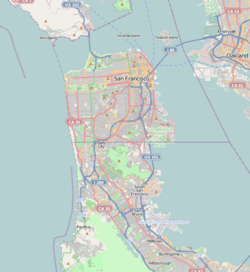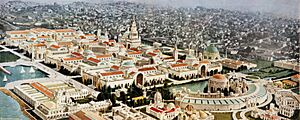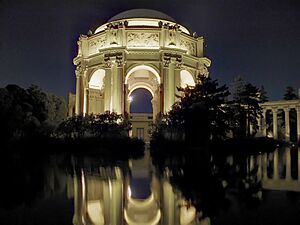Palace of Fine Arts facts for kids
|
Palace of Fine Arts
|
|

The Palace of Fine Arts, 2020
|
|
| Location | 3301 Lyon St., San Francisco, California |
|---|---|
| Area | 17 acres (6.9 ha) |
| Architect | William Gladstone Merchant; Bernard Maybeck |
| Architectural style | Beaux-Arts |
| Website | https://palaceoffinearts.com/ |
| NRHP reference No. | 04000659 |
Quick facts for kids Significant dates |
|
| Added to NRHP | December 5, 2005 |
The Palace of Fine Arts is a beautiful building in San Francisco, California. It is located in the city's Marina District. This amazing structure was first built for a big event called the Panama–Pacific International Exposition in 1915. Its main purpose was to show off incredible works of art.
The original building was taken down and completely rebuilt between 1964 and 1974. Today, it is the only building from that 1915 event that still stands in its original spot. The Palace of Fine Arts was designed to look like an old, crumbling ruin from ancient Rome. It has become one of San Francisco's most famous landmarks.
The most important part of the building is a tall, open rotunda. It stands about 162 feet (49 meters) high. On one side, a calm lagoon surrounds it. On the other side, a large, curved exhibition center is connected by colonnades (rows of columns). As of 2019, the exhibition center is used for many events. These include weddings and big trade fairs. In early 2009, the lagoons and walkways were fixed up. The building also got stronger to protect against earthquakes.
Contents
History of the Palace
The Palace of Fine Arts was one of ten main palaces at the 1915 Panama-Pacific Exhibition. This huge fair also had palaces for Education, Liberal Arts, and many other topics. The Palace of Fine Arts was designed by an architect named Bernard Maybeck. His job was to create a peaceful place. Visitors could relax there after seeing the busy fairgrounds. They could also enjoy the paintings and sculptures inside the building.
Maybeck designed the Palace to look like an old ruin from a different time. He got his ideas from Roman and Ancient Greek architecture styles. He was also inspired by an etching of old Roman ruins. Another idea came from a painting called Isle of the Dead.
Rebuilding the Palace
The original Palace was not built to last forever. It was made mostly of wood frames covered with a mix of plaster and fiber. This material was called "staff." Because of this, the building started to crumble by the 1950s. Even though it looked like an old ruin, it was falling apart too much.
So, in 1964, the original Palace was completely taken down. Only the steel frame of the exhibition hall remained. The buildings were then rebuilt using strong, lightweight concrete. Steel beams were used for the rotunda's dome. All the decorations and sculptures were made new. A local artist named Spero Anargyros created many of the larger sculptures. The rebuilding finished in 1974.
What the Palace Was Used For
Most of the buildings from the 1915 exhibition were torn down after the fair ended. But people loved the Palace of Fine Arts so much that they wanted to save it. A group called the Palace Preservation League was started by Phoebe Apperson Hearst to protect it.
For a while, the Palace was used to show art all the time. During the Great Depression, artists were hired to fix the murals on the rotunda's ceiling. From 1934 to 1942, the exhibition hall had eighteen lighted tennis courts!
During World War II, the military used the Palace to store trucks and jeeps. After the war, when the United Nations was created in San Francisco, cars for world leaders were kept there. From 1947 on, the hall was used for many different things. It was a warehouse for the city's Park Department. It was also a place to store flags and tents. For a short time, it was even the main office for the Fire Department.
In 1969, the exhibition hall became home to the Exploratorium. This is an interactive museum where you can learn by doing things. In 1970, a theater with 966 seats also opened there. On October 6, 1976, the Palace of Fine Arts hosted an important debate between two US presidential candidates, Gerald Ford and Jimmy Carter.
In 2003, the City of San Francisco and a group called the Maybeck Foundation worked together. They started a project to restore the Palace. By 2010, they had finished fixing and strengthening the dome, rotunda, columns, and lagoon. The Exploratorium museum moved to a new location in January 2013.
The popular TV game show Wheel of Fortune filmed episodes at the Palace in 1992 and 1996. In April 2020, during the coronavirus pandemic, there were plans to use the Palace as a temporary shelter. However, these plans were changed soon after.
Palace Design
The Palace of Fine Arts is built around a small, man-made lagoon. It has a wide, 1,100-foot (335-meter) long pergola (a shaded walkway with columns). A central rotunda is located right by the water. The lagoon was designed to look like the calm waters found in old European settings. The water acts like a mirror, reflecting the grand buildings. It also gives a clear view to admire them from a distance.
The building has many beautiful decorations. Around the rotunda's top part, there are three repeating panels by Bruno Zimm. These panels show "The Struggle for the Beautiful," which represents ancient Greek culture. Ulric Ellerhusen created the sad-looking women on top of the columns. He also made the carved decorations and figures that represent Contemplation, Wonderment, and Meditation.
The inside of the rotunda's dome has eight large spaces. These originally held murals (wall paintings) by Robert Reid. Four of these paintings showed how art was created and born. They also showed how art was accepted by people. The other four paintings showed the "golds" of California. These included poppies, citrus fruits, real gold, and wheat.

Gallery
See also
 In Spanish: Palacio de Bellas Artes (San Francisco) para niños
In Spanish: Palacio de Bellas Artes (San Francisco) para niños











